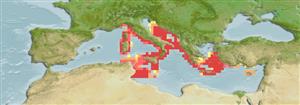Teleostei (teleosts) >
Callionymiformes (Dragonets) >
Callionymidae (Dragonets)
Etymology: Callionymus: Greek, kallion, comparative of kallos = beautiful + Greek, onyma = name; with a better name .
More on author: Valenciennes.
Environment: milieu / climate zone / depth range / distribution range
Ecology
Marine; demersal. Subtropical; 45°N - 34°N, 8°E - 34°E
Mediterranean Sea: Gulf of Genoa to the western Aegean Sea. Also known from the southern and eastern Black Sea.
Size / Weight / Age
Maturity: Lm ? range ? - ? cm
Max length : 16.5 cm TL male/unsexed; (Ref. 53342)
Occurs on sandy bottoms. Feeds on small bottom invertebrates, mainly worms and crustaceans (Ref. 5968).
Life cycle and mating behavior
Maturities | Reproduction | Spawnings | Egg(s) | Fecundities | Larvae
Fricke, R., 1986. Callionymidae. p. 1086-1093. In P.J.P. Whitehead, M.-L. Bauchot, J.-C. Hureau, J. Nielsen and E. Tortonese (eds.) Fishes of the North-eastern Atlantic and the Mediterranean. UNESCO, Paris. Vol. 3. (Ref. 5968)
IUCN Red List Status (Ref. 130435)
Threat to humans
Harmless
Human uses
Tools
Special reports
Download XML
Internet sources
Estimates based on models
Preferred temperature (Ref.
123201): 13.9 - 17.7, mean 15.1 °C (based on 52 cells).
Phylogenetic diversity index (Ref.
82804): PD
50 = 0.5000 [Uniqueness, from 0.5 = low to 2.0 = high].
Bayesian length-weight: a=0.00891 (0.00480 - 0.01654), b=2.78 (2.62 - 2.94), in cm total length, based on LWR estimates for this species & Genus-body shape (Ref.
93245).
Trophic level (Ref.
69278): 3.3 ±0.40 se; based on food items.
Resilience (Ref.
120179): High, minimum population doubling time less than 15 months (Preliminary K or Fecundity.).
Fishing Vulnerability (Ref.
59153): Low vulnerability (10 of 100).
Nutrients (Ref.
124155): Calcium = 102 [23, 308] mg/100g; Iron = 1.28 [0.48, 4.67] mg/100g; Protein = 3.2 [0.0, 7.0] %; Omega3 = 0.319 [0.139, 0.712] g/100g; Selenium = 18.9 [3.8, 55.1] μg/100g; VitaminA = 18.7 [5.9, 56.1] μg/100g; Zinc = 0.99 [0.50, 1.99] mg/100g (wet weight);
